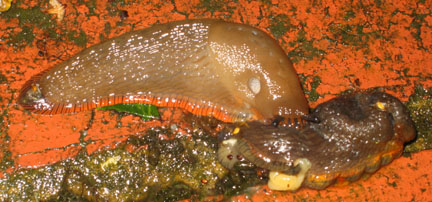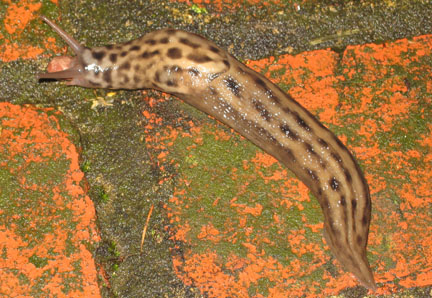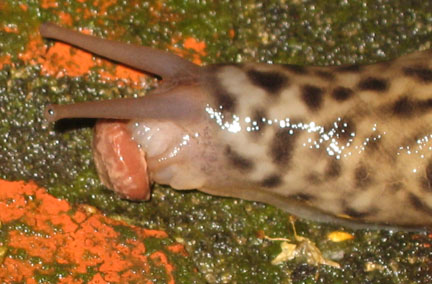Slugging it out
By Ruth D’Alessandro, The Wildlife Gardener It’s a slug eat slug world BBC news online says that there are 15 BILLION slugs in Britain. That’s two hundred and fifty slugs for every single one of us living in the United Kingdom. And I find that astonishing. Astonishing because I thought there would be more, going by the vast slimy influx of seemingly thousands of these gastropods into The Wildlife Garden. Perhaps I am doing all you flat-dwellers a favour by domiciling your slugs. It has been perfect summer holiday weather ” for the slugs. And the size of them! I can’t walk outside in the evening without stepping on a rubbery lump and being catapulted into the air. Treading on them does not kill them; they just glare at me for interrupting their forays. I had long believed that it’s not the huge slugs gardeners need to worry about, but the small ones that ate all your veg. Now I’m not so sure. I thought that the huge black, red, brown and cream slugs were detritivores, happier clearing up the cat poo, rotting fruit, compost and even their cousins that the dog trod on than attacking the veg patch.

Now, an entire row of dwarf beans and one of gorgeous Genovese basil has been gorged. And a big red slug was seen hiding in the spinach. Now dear Wildlife Garden readers, can you help me? Are these big slugs destructive, or are they nature’s bin men, sorry, operatives? Has anyone seen Big Slugs wantonly eating their plants? Answers on the blog please. The Leopard That Doesn’t Need To Change Its Spots There is, however, one slug I am always delighted to see, and that is the leopard slug (Limax maximus):

It is an innocent, and rather beautiful visitor to our gardens. It doesn’t eat plants, only fungi, decaying matter, and here, a Smartie that one of the children dropped on the doorstep:

The Leopard slug is a limacid slug, which means that it has a small calcareous shell under that slimy cloak-like mantle on its back. If you happen to touch the mantle you can feel the shell underneath. In one of my school French essays a slug was escargot sans maison. In the case of the leopard slug, with its tiny calcareous shell, it’s more like escargot avec studio flat. And just for all you students of French out there who are desperate to include slugs in your essays, the proper word is une limace. So now you know. Treasure your leopard slugs if you have them. They do no harm to your garden, and if you are really lucky, you may witness some of the weirdest sex in the animal world. [youtube]VtD5dxTcXm4[/youtube]
- Spurn Spawn! - 26th February, 2014
- Bluebells on wheels: axles of evil? - 2nd February, 2011
- Raising the ba: Wildlife and the Ancient Egyptian Book of the Dead - 8th January, 2011

Slugs are beautiful and very under valued. They are a valuable part of nature. It saddens me deeply that people like gardeners spend so much time amongst nature and fail blindly to see how it works. I recommend learning and reading up on natural forest gardening and permaculture. If you planted plants like they occur in nature, no insect control or weed control would be needed.
The leopards will certainly be clearing up detritis. The very cold winter may have finished off some hibernating slugs & snails and their eggs. The dry weather seems to have encouraged them out less too.
For years have been besieged by slugs and huge quantities of large snails. Used to gather them in a covered bucket at dawn and dusk and take them to wasteground about a quarter of a mile away and tip them out onto the ground for the birds.
This year my plants are not being eaten nearly as much and I have a large quantity of leopard slugs in the garden. I now have pet rabbits & the leopards seem to feed on rabbit pooh. Could they also be killing off the pesky garden snails and slugs? If so, what wonderful creatures they are. I have never, ever used slug pellets.
They are amazing. And I’m delighted that your limace will have a happy life in la compost heap.
hi, we now live in France and have seen a great leopard slug today whilst making a second compost heap- never realised slugs could be so amazing, and attractive. really didn’t know what I was looking at at first!!thanks for the info on your site.
Hi old man rich – agree with you – I am very uncomfortable using pellets. Nematodes are good, although I guess they would infest the leopard slugs too. Perhaps this year I just accept the munching and hope for a dryer summer next year.
Not convinced that pellets are harmless to other wildlife, despite the labels (just call me Mr cynical. I use nematodes(available online) to control my slug population. Not to good with snails though. Have to resort to manually collecting them at dawn & dropping them in a bucket of salt water.
Hi ghostmoth – even diehard organic gardeners have resorted to slug pellets this year. I’m reluctant to use them because they cause such an obviously agonising slow frothing death, especially to the large slugs. And now of course I just can’t risk poisoning the leopard slugs. So beer is a good idea. Presumably they like the sugar in beer as much as they like it in Smarties.
I love the idea of being glared at by slugs! I gave up my battle with the slimy ones many years ago and now only plant things I know they won’t eat – nemesia, dahlias, sweet peas, etc. Beer traps are the only thing I’ve found to work and not a bad way to go either. Good luck!